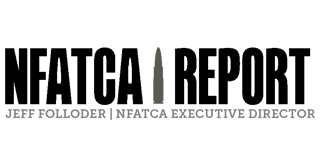JEFF FOLLODER | NFATCA EXECUTIVE DIRECTOR
For true goalpost shifting, one only has to look at the chaos that has been created via the ATF’s ever-changing guidance/position on braces for pistols.
“Moving the goalposts” is a metaphor, derived from goal-based sports, that means to change the criteria (goal) of a process or competition while it is still in progress, in such a way that the new goal offers one side an intentional advantage or disadvantage. The term is often used in business or politics to imply bad faith on the part of those setting goals for others to meet, by arbitrarily making additional demands just as the initial ones are about to be met. Accusations of this form of abuse tend to occur when there are unstated assumptions that are obvious to one party but not to another. There are many who would claim, with some serious justification, that the Department of Justice and the Bureau of Alcohol, Tobacco, Firearms and Explosives (ATF), specifically, employ such methods on a regular basis, often without notice or alert. And while the process of Rule Making, as outlined in the Administrative Procedures Act demands such notice in terms of regulations, there is generally no mandate to let the regulated know the terms by which they will be regulated. Such is the case with a variety of aspects under the purview of the ATF.
The first example would be the longstanding activity known as compliance inspections. The ATF is allowed to inspect the premises and operations of a licensee no more than once a year without cause. And while some license holders may not have been inspected in many years, there are those who, indeed, are inspected annually. If more than one Industry Operations Inspector (IOI) performs this inspection in successive visits, it is not uncommon to receive conflicting guidance on just what the right way to do things is. Many licensees have asked, in very cooperative and non-threatening terms, just how they will be graded. They have made this request, because it often feels like the IOIs are shifting the goalposts, if only to give the appearance of a wrist slap after an inspection has been concluded. Some folks have had enough, and the good folks at Gun Owners of America (GOA) held the line with a Freedom of Information Act (FOIA) demand action and finally obtained a redacted copy of the current Firearms Industry Operations Manual. They made the result of this action public, and now everyone has access to the “play book” that should tell them exactly what criteria will be used to assess compliance. That manual can be downloaded here: nfatca.org/pubs/IOI_Manual_2017.pdf. It is actually quite useful and enlightening. We can only assume that it will remain valid … until the goalposts move again.
Under a similar scenario, the NFATCA worked for years with what was then called the “Firearms Technology Branch (FTB).” Great progress was made in establishing a foundation for the FTB Handbook, a guide that would have been similar to the NFA Handbook (originally authored by NFATCA) that has enjoyed such great success. Several hundred pages were authored, amassed, compiled and assembled into a rather large three-ring binder. Missing were many very key Standard Operating Procedure (SOP) documents that clearly established the goalposts of just how specific evaluations were conducted. In this case, the goalposts were not moved. They were also never actually established. That three-ring binder is still awaiting completion, though ATF informs us that it is unlikely that the requested SOPs will ever be revealed. At least we know that they exist.
For true goalpost shifting, one only has to look at the chaos that has been created via the ATF’s ever-changing guidance/position on braces for pistols. Shouldering a brace is legal. Shouldering a brace is illegal. Occasionally shouldering a brace is legal, but if you do it regularly, you need to register the item as a short-barreled rifle (SBR). Add a foam pad or a rubber cane tip (really) to your brace, and it most certainly is an SBR. By the time you read this article, the ATF may have very well added yet another wrinkle to the playing field of braces. Here’s a pro tip for Congress: Alleviate much of this chaos by doing two things. Require complete transparency on exactly how all regulations will be enforced and drop all short-barreled long arms and suppressors from the National Firearms Act (NFA). There. Done!
The NFATCA continues to press the regulators to work with the regulated in cooperative ways instead of combative tactics. We continue to achieve success, albeit slowly, by staying the course. We thank all of those who have generously supported our efforts and all of those will become new members. We are looking forward to the next 15 years!
Would you like to join our effort? Head over to nfatca.org and click on the Join Now! link on the left.
| This article first appeared in Small Arms Review V24N3 (March 2020) |












